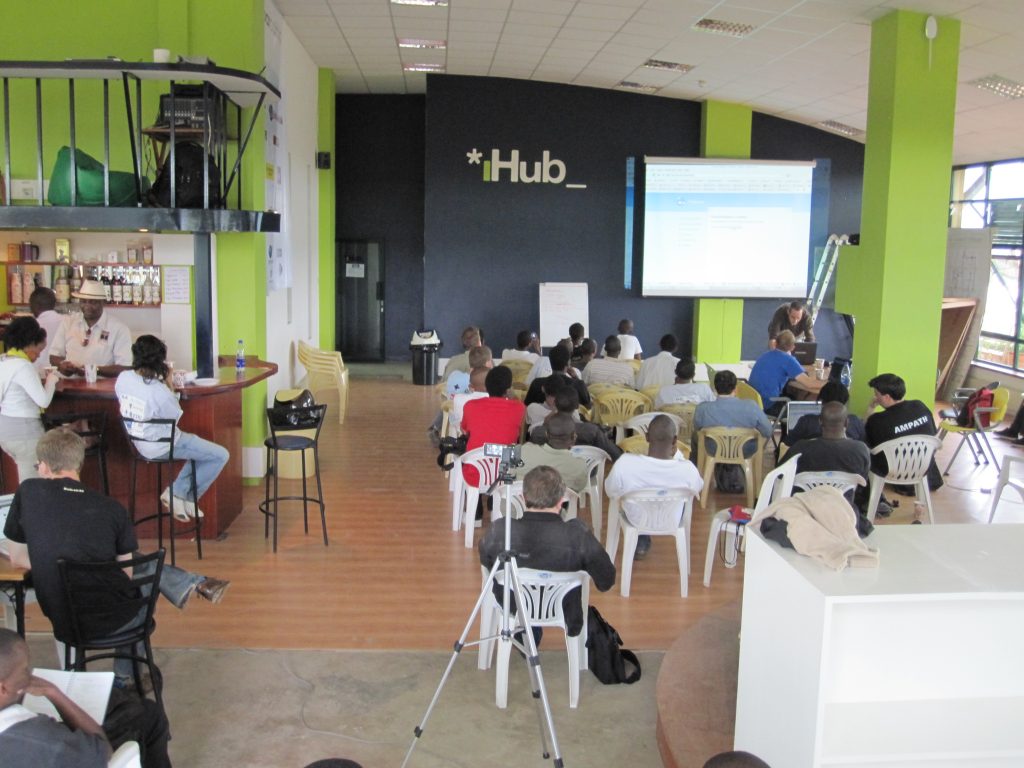Nairobi’s iHub (Innovation Hub) is an open space created for web designers, mobile application developers and programmers from Kenya’s capital city area. The open co-working space also serves as an incubator for students, tech professionals, young entrepreneurs as well as investors and venture capitalist.
The iHub facility can be accessed without charge upon subscription to the free membership. It is strategically located on the fourth floor of the Bishop Magua Centre on Ngong Road directly opposite the Uchumi Hyper. From this location, the city centre as well as hotels and restaurants can be easily and quickly accessed by public transportation.
In essence, Nairobi’s iHub is the city’s nerve centre for technology, where entrepreneurs can develop ideas, find funding, and set up their businesses. It is also the best place for the tech community, businesses, investors as well as the government to connect with each other.
Nairobi’s iHub – History in Brief
It all started with a simple idea in 2008 at Barcamp Nairobi about creating a static space for the tech community in Kenya. In 2009, a submarine fibre optic cable was established on Mombasa beaches, about 500 kilometres east of Nairobi, providing a boost to the idea of creating the iHub. The mission of Ushahidi, the only organization that came forward to provide funding for setting up the iHub, was to help the upcoming startups in the country.
The actual work on iHub started in March 2010 and by June it was ready for use. Even though the funds for the first two years of its operation were provided by Ushahidi, it is run as the organization’s independent initiative.
Today, Nairobi is teeming with technology startups such as Shop Soko, which similar to Etsy, enables shopkeepers to sell goods to buyers around the world. Further, the capital city has also become the African base for large technology companies such as IBM, Google, and Intel. Over the first decade of this millennium, Kenya’s tech exports have risen from USD16 million to USD360 million.
In the Kilimani neighbourhood of Nairobi, the centre of the tech scene, many high rise and glass-clad office buildings are being built. Meanwhile, the government is planning to develop a special economic zone called Konza Techno City to attract more technology companies.
Nairobi’s iHub – What Makes It Work

iHub’s success can be attributed mainly to the tech community that works together. The community is at the heart of whatever is happening at the iHub. It is the community that designed the layout of the rooms and logo. They run the network, built the website, hold events, created the house rules, and drive the growth of the space. The company’s responsibility is to provide the basic infrastructure.
The advisory board of iHub includes Erik Hersman, co-founder of Ushahidi, and four of Nairobi’s highly influential and credible technology players. The board decides as to who can be given green-level membership from among thousands of white-level members. Ultimately, only the green-level members are allowed to have free as well as unfettered access to Nairobi’s iHub facility.
As of now, revenue comes from red members, events, and the research arm R@iHub. The m:lab, another space developed one floor below the iHub, acts as the incubator. It has the same space area as the iHub and it is all about professional technology companies creating quality products and selling them in the market. The sister-facility of iHub, which shares many services with the iHub, also extends financial support. Moreover, the iHub and m:lab have built a strong relationship with strong corporates in Nairobi. They include Nokia, Wananchi, Google, Microsoft, MIH, and InMobi. The iHub also maintains strong connections with the government of Kenya, though they do not provide any financial support. This is applicable in the case of academia as well.
A year-long study was taken up on to understand the effectiveness of various ICT Hubs established across Africa. As part of this study, the iHub Research carried out a 3-month study to have a clear understanding of the iHub model and its impact on individual members. The results of the study were published in May 2012 after surveying the performance of 7,011 members and interviewing the various stakeholders. Hilda Moraa prepared the report and Wangechi Mwangi was the co-author.
The goal of the research was to understand as to how the ICT Hubs impacted entrepreneurship development in the country. An ICT Hub can be described as space for technologists to get together and bounce ideas around, work, program, design, and network to bring their innovative ideas to fruition. iHub was the first ICT Hub to be profiled out of the 15 Hubs forming part of this study.
Some of the important findings noted in the report are as follows:
There were a total of 7,011 members, including different membership tiers, in Nairobi’s iHub. While there were 5,915 (84 percent) male members, the number of female members were 1,096 (16 percent). Even though the number of female members was increasing, enhancing female participation was a challenge that the sector had to contend with.
As many as 12 startups, including Akirachix, Afrinnovator, Wezatele, and Wingu Technologies, were identified as startup companies.
An interesting observation of a report published by the Capital Markets Authority of Kenya after carrying out a research study was that one of the major sources of funding for the Small and Medium Enterprises or SMEs in Kenya was personal loans and that provided by friends (50.3 percent). The report’s topic was “Opportunities and Challenges for investing in the ICT Sector in East Africa”.
According to the report, the largest funding deficiency was in the early stage or at the ‘seed’ level at that time. This was the situation specifically in the case of software startups. The iHub’s research findings mirrored the trend highlighted in the report published by Kenya’s Capital Markets Authority with a majority of the iHub respondents sourcing the funding for their start-ups either from their own personal savings or that of their friends and family members.
Most start-ups generated revenues by designing their customers’ products. Seventy-seven percent of the startups interviewed said that they had customers for their products or they offered consultancy services in order to generate an income.
The survey determined that the ICT Hubs need to train the various startups on approaching the market either through mentorship or by way of programs conducted by these Hubs.
Most of the clients of the startups were sourced through networking by the iHub community. The iHub members referred each other to various potential clients. In addition, the iHub members made an effort to connect with prospective clients during the events held at the iHub.
The key challenges that were identified by the startup companies included the lack of required funding and quality mentorship, increasing market competition, challenges in accurately pegging pricing schemes, competing with larger multinationals, non-availability of data, and unverified assumptions as regards the market.
Nairobi’s iHub – Its Importance In Developing Africa’s Tech Community

Nairobi’s tech boom helped the country to become the hosts for the Habitat III Preparatory Committee’s second session in April 2015. Habitat III is a conference organized by the United Nations once every 20 years. Habitat III was held in 2016. In many ways, Nairobi represented a hope for the urban future of the planet, as population growth and job creation due to investment and infrastructure development in fast-growing cities.
Social enterprises are on the rise
Nairobi’s tech industry has been a positive force in ushering change, especially among the entrepreneurs involved in the startup scene. They feel that what is good for Kibera slum dwellers is also good for Kilimani techies. While the Silicon Valley is all about improving efficiencies, Nairobi is about providing solutions for real-life challenges.
Looking at Shop Soko again, Ella Peinovich, the founder of the company, came to the country from the U.S. She came as an architecture student that wanted to work on sanitation issues. Later on, she relocated to Nairobi and set up a company with a Kenyan as her partner in 2012. Any business that creates jobs contributes to the growth of the local community as well.
She noticed that the craftspeople were selling their wares on the roadside and in local markets in dirty conditions. They also faced security risks because all dealings were done through cash transactions. Access to the markets through Shop Soko helped these vendors increase their revenues on average by 400 percent. In addition to creating safer working conditions, it improved their financial stability as well.
Shop Soko was started at GrowthHub in Kilimani. It is an incubator as well as an accelerator space. Most of the startups in Nairobi can track their origins to the iHub or the GrowthHub. As much as 25 percent of the businesses that started in these spaces are social enterprises. One of the ways in which the iHub fosters the tech community is by organizing chats with entrepreneur forums and global technology leaders.
Soko Text is another example. The SMS-platform enables street vendors to aggregate their purchasing power. Currently, it is being limited to vegetable purchases. Vendors send their order messages to Soko Text. The platform collects the orders and makes bulk purchases directly from them. The orders are then shipped to a distribution centre near the area where the vendors live. This way the vendors save time as they don’t have to travel to the wholesale markets. It also helps them save money as middlemen are eliminated.
BRCK, the startup that was co-founded by Erik Hersman, provides solutions for the spotty Internet access problems. The rugged Wi-Fi router sold by the company uses cellular signals for providing mobile Internet to as many as 20 users for about eight hours (battery life).
Success Ingredients
President Uhuru Kenyatta’s unannounced visit to iHub resulted in the government offering more than moral support. The accelerator Nailab, located adjacent to iHub, received USD$1.6 million from the government of Kenya in 2013. More recently, 30 percent of public contracts (especially in hardware and software) were opened up to young entrepreneurs. In addition, the government has committed USD10.7 million to Enterprise Kenya, which links local businesses and international markets.
These investments complement the fundamental infrastructure improvements. There has been a significant improvement in broadband connections and the local telecom companies are competing to provide fibre optic connections to the household. Kenya Power has also been successful in providing stable electricity service.
The tech community in Nairobi has also successfully developed the home-grown innovation M-PESA for mobile payments. As much as 50 percent of the start-ups are dependent on it now. It is much harder to shop at Shop Soko or broker deals at Soko Text in the absence of M-PESA.
The success of iHub has spurred the mushrooming of other incubators and hubs around Africa.
Current Scenario
Six years after its launch Nairobi’s iHub, Africa’s most successful technology hub, Erik Hersman announced its goal to become 100 percent self-funded. A group of investors came forward to invest in the iHub to help it grow. They included are Professor Ndemo, Becky Wanjiku, Miguel Granier, and Ken Mwenda.
The iHub Limited was finally acquired by BSP Fund LLC, a venture capital firm, for an undisclosed sum. According to a statement given by Erik Hersman, a former shareholder, the transaction was completed last year. Hersman owned 49.95 percent of iHub before the deal. The other shareholders were Josiah Mugambi (49.95 percent), and Juliana Rotich and David Kobia (0.05 percent each).
Hersman has not revealed the value of the deal but has described it as nominal. However, the regulatory filing documents at the Competition Authority, Kenya, reveal that I-Hub and Gearbox had a combined turnover of Sh299.1 million as of 2015. This classifies the combined business as a medium-sized enterprise.



26 comments
Comments are closed.